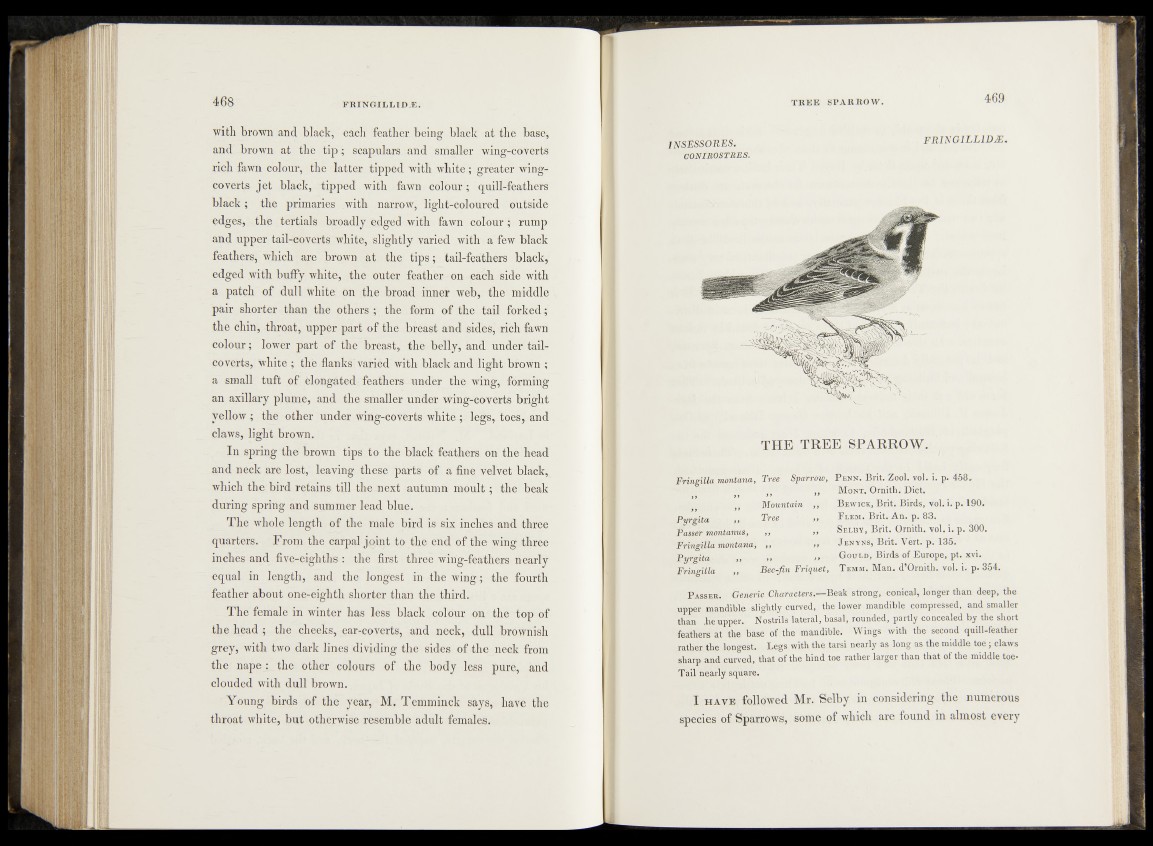
with brown and black, each feather being black at the base,
and brown at the tip ; scapulars and smaller wing-coverts
rich fawn colour, the latter tipped with white; greater wing-
coverts jet black, tipped with fawn colour; quill-feathers
black; the primaries with narrow, light-coloured outside
ed ges, the tertials broadly edged with fawn colour ; rump
and upper tail-coverts white, slightly varied with a few black
feathers, which are brown at the tips; tail-feathers black,
edged with huffy white, the outer feather on each side with
a patch of dull white on the broad inner web, the middle
pair shorter than the others ; the form of the tail forked;
the chin, throat, upper part of the breast and sides, rich fawn
colour; lower part of the breast, the belly, and under tail-
coverts, white ; the flanks varied with black and light brown ;
a small tuft of elongated feathers under the wing, forming
an axillary plume, and the smaller under wing-coverts bright
yellow ; the other under wing-coverts white ; legs, toes, and
claws, light brown.
In spring the brown tips to the black feathers on the head
and neck are lost, leaving these parts of a fine velvet black,
which the bird retains till the next autumn moult; the beak
during spring and summer lead blue.
The whole length of the male bird is six inches and three
quarters. From the carpal joint to the end of the wing three
inches and five-eighths : the first three wing-feathers nearly
equal in length, and the longest in the wing; the fourth
feather about one-eighth shorter than the third.
The female in winter has less black colour on the top of
the head; the cheeks, ear-coverts, and neck, dull brownish
grey, with two dark lines dividing the sides of the neck from
the nape : the other colours of the body less pure, and
clouded with dull brown.
Young birds of the year, M. Temminck says, have the
throat white, but otherwise resemble adult females.
1NSESSORES.
CONIROSTRES.
FRIKG1LL1D1E.
t h e t r e e s p a r r o w .
Fringilla montana, Tree Sparrow, P enn. Brit. Zool. vol. i. p. 458.
tt ,, M ont. Ornith. Diet,
tat Mountain , , B ewick, Brit. Birds, vol. i. p. 190.
Pyrgita „ Tree „ F lem. Brit. An. p. 83.
Passer montanus, „ .. S elby, Brit. Ornith. vol. i. p. 300.
Fringilla montana, ,, ,> J enyns, Brit. Vert. p. 135.
Pyrgita ,, ,, ,, G ould, Birds of Europe, pt. xvi.
Fringilla „ Bee-Jin Friquet, T im m . Man. d’Ornith. vol. i. p. 354.
P asser. Generic Characters.—Beak strong, conical, longer than deep, the
upper mandible slightly curved, the lower mandible compressed, and smaller
than ,he upper. Nostrils lateral, basal, rounded, partly concealed by the short
feathers at the base of the mandible. Wings with the second quill-feather
rather the longest. Legs with the tarsi nearly as long as the middle toe; claws
sharp and curved, that of the hind toe rather larger than that of the middle toe-
Tail nearly square.
I H A V E followed Mr. Selby in considering the numerous
species of Sparrows, some of which are found in almost every